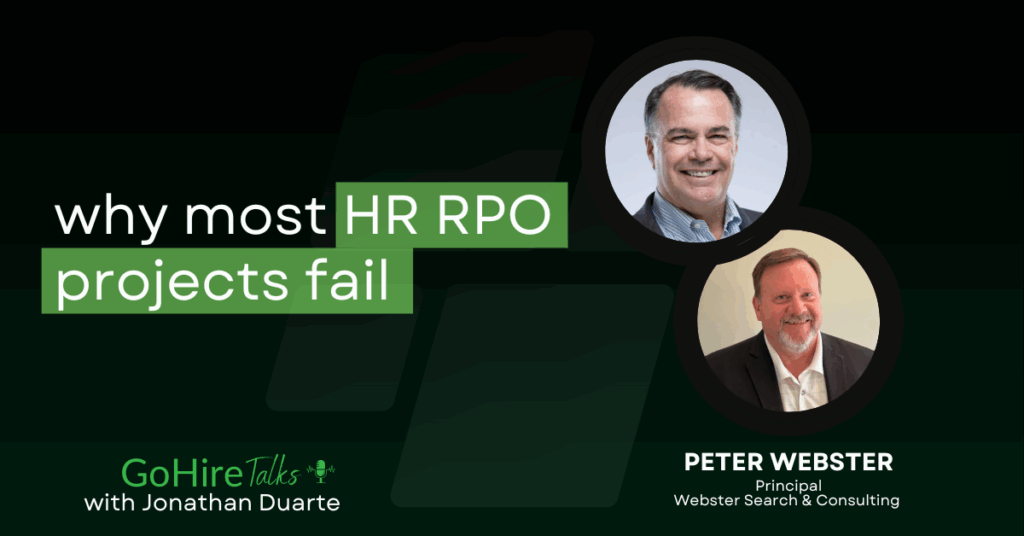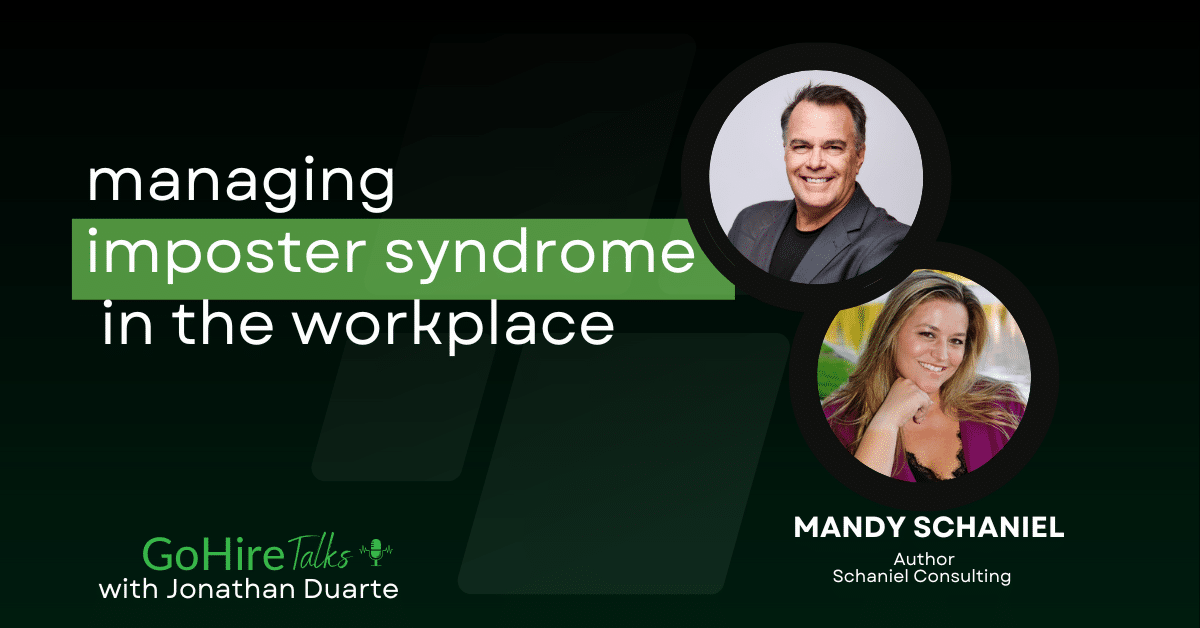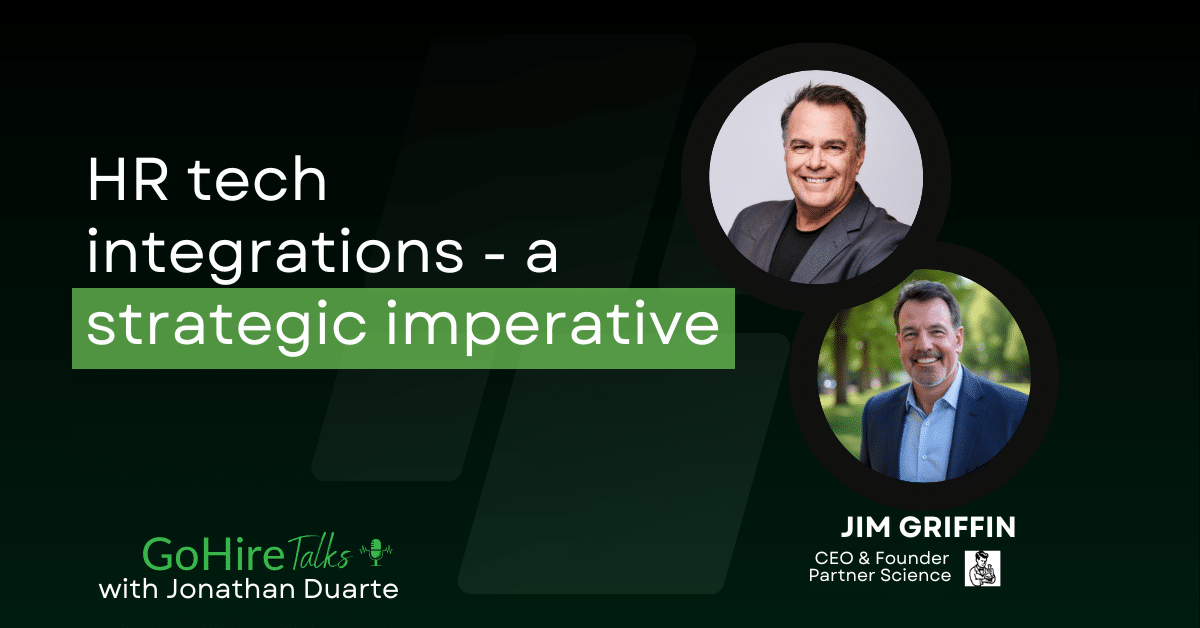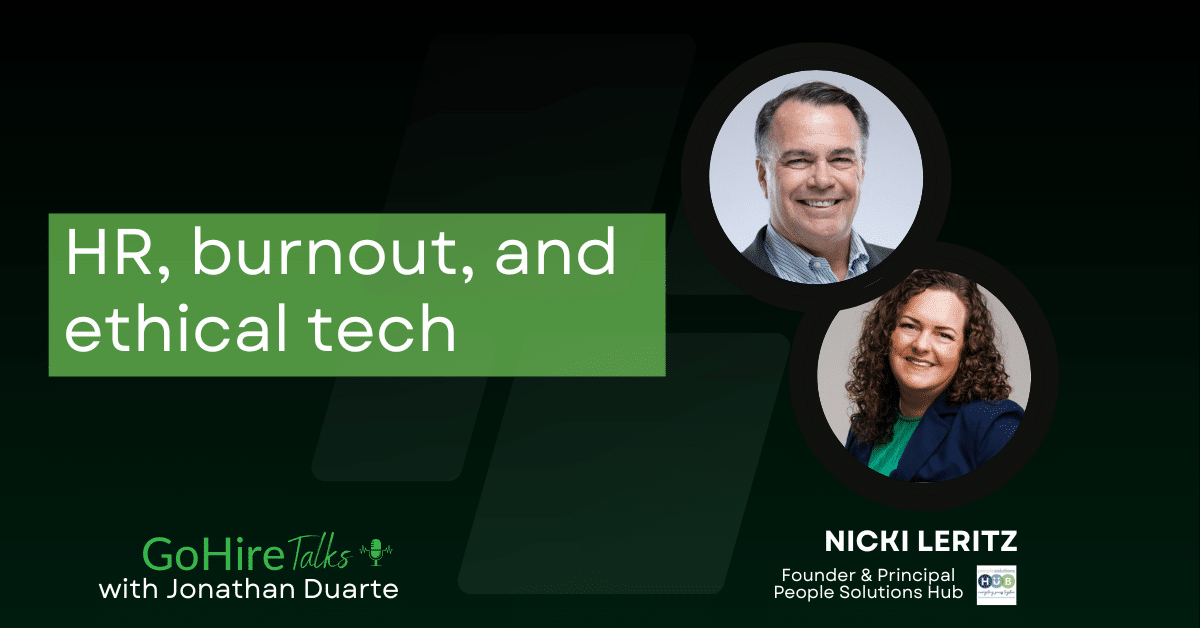
In this episode of GoHire Talks, we sat down with Peter Webster — founder of Webster Search & Consulting — to explore why most HR RPO projects fail and one of the HR industry’s most common pitfalls: trying to automate broken processes with shiny new tech.
Peter, a veteran in HR transformation, RPO implementation, and enterprise recruiting systems, walks us through the brutal truths about HR process automation and change management in HR tech. With decades of experience leading TA functions at global organizations and implementing platforms like Taleo and Workday, Peter doesn’t just theorize — he’s done the hard work.
Whether you’re considering an RPO partner, rolling out your fifth ATS, or just trying to get a handle on your HR tech stack, this episode is a must-listen. The biggest takeaway?
If you don’t know what problem you’re solving, no software — no matter how slick — will save you.
 Key Insights from Peter Webster
Key Insights from Peter Webster
Tech Doesn’t Fix Bad Process
Technology should complement your hiring process, not define it. If your workflows are broken, automation will just help you fail faster.Most HR Tech Isn’t Even Used
Peter estimates — and Josh Bersin loosely backs this — that 75% of HR tech functionality is never implemented. Companies are buying expensive software they don’t use.RPOs Need More Than a Contract
Success in RPO implementation requires full process alignment. Without a clear business goal and mutual understanding, things break fast.“Big Bang” Tech Rollouts Rarely Work
Peter’s preferred method? Regional pilots. Global implementations (like Taleo or Workday) succeed only when staged thoughtfully.AI Is Not a Silver Bullet
HR leaders rushing into AI often forget: garbage in, garbage out. If your process isn’t working, AI will only amplify the problem.Cross-Functional Buy-In Is Critical
IT, HR, and leadership must be on the same page. Siloed decisions on tools or workflows lead to disjointed tech stacks and user frustration.
 Why RPO Projects Fail (and How to Make Them Work)
Why RPO Projects Fail (and How to Make Them Work)
Peter’s experience implementing RPOs showed a common pattern: clients often don’t fully understand what they need, or what their current process even is.
“It’s not plug-and-play. You can’t just drop in an RPO and expect magic.”
To avoid failure, organizations need to:
- Map current processes in detail
- Identify what the RPO is meant to solve (volume? speed? quality?)
- Build in flexibility for changing business needs
- Integrate RPO workflows with internal systems and teams
Successful RPO is a partnership, not a handoff.
 Fixing the HR Tech Stack Starts with Audit & Alignment
Fixing the HR Tech Stack Starts with Audit & Alignment
Peter’s recent consulting work focuses on HR system audits — and what he’s found is telling.
Companies often:
- Pay for tools they never implemented
- Stack new platforms on top of broken workflows
- Ignore the process cost of implementation and change
“There’s the license cost — and then there’s the real cost to implement.”
The fix?
Start with a full-stack audit. Understand what you’re using, what you’re paying for, and what your actual business needs are. Then build or replace accordingly — with a process-first mindset.
 Change Management in HR Tech Isn’t Optional
Change Management in HR Tech Isn’t Optional
It’s tempting to rush implementation to show progress. But shaving three months off a six-month rollout often leads to broken processes, poor adoption, and frustrated users.
From talent acquisition to benefits to succession planning — every HR function relies on data accuracy and user experience. That means:
- Involve end-users early
- Prioritize usability
- Communicate change impact across teams
- Allow time for testing and iteration
 AI in HR? Proceed with Caution
AI in HR? Proceed with Caution
AI is everywhere, but Peter offers a word of warning:
“AI can’t fix your hiring problems if you don’t know what they are.”
Yes, AI can assist in sourcing, screening, and scheduling — but only if it’s implemented into a stable, well-defined process. If you’re unclear on your funnel metrics or workflow gaps, adding AI is like throwing gasoline on a dumpster fire.
 About the Guest
About the Guest
A huge thanks to Peter Webster, founder of Webster Search & Consulting, for joining us. Peter brings over two decades of leadership in talent acquisition, enterprise HR systems, and global recruiting transformation.
Full Podcast Transcript:
[00:00:00]
[00:00:00] **Jonathan Duarte:** Alright, welcome everyone, we’ve got another great guest at GoHire Talks. We’ve got Peter Webster with us, and Peter’s been in the industry a long time. Doing lots of things in HR and talent acquisition, a lot of things in process automation and got a big area of expertise. So let’s just jump in right away.
[00:00:20] Peter, why don’t you give me a little bit of introduction about you and your kind of past history in HR and recruiting.
[00:00:27] **Peter Webster:** Sure. Thanks, Jonathan. I appreciate the chance to talk with you and to anyone else that’s out there at this point. So I’ve been involved in HR and technology heavily in the talent acquisition space longer than I care to admit.
[00:00:41] I started my recruiting days when there was no internet. I started in an agency where it was reading the Sunday paper and going through job ads to call companies and ask them if we could work on a job and then going through resumes and calling candidates. So that’s how far back I [00:01:00] go.
[00:01:00] **Jonathan Duarte:** That’s pre fax days.
[00:01:01] **Peter Webster:** So yeah, pre fax, I remember. Oh, okay. Let’s not go down that road. So I’ve seen a lot of things change from talent acquisition, just being filling jobs, getting people in the door and that’s all that it is, to becoming a seat at the table with the leadership of HR, as well as the executive leadership within companies.
[00:01:26] When you think of, when I look at my career I’ve been on, I’ll say, all sides of the desk. I’ve been on the sides of the desk where I’ve been supporting companies from a third party standpoint to fill critical roles, whether it be in aerospace or pharma, biotech, to being the person on the side of the desk that’s leading an organization, that’s trying to expand a sales force in the pharmaceutical industry or build out and expand the location in the [00:02:00] biotechnology manufacturing and bringing the resources to bear to, to meet the business needs, to find talent, to get talent in as efficiently as possible.
[00:02:11] **Jonathan Duarte:** One of the things you had mentioned about and I knew you were doing implementation stuff in the RPO space. What’s been your, maybe one or two examples of. A situation you walked into that you had to just get to the business process. You had to figure out the business process for recruiting.
[00:02:32] Maybe you came in and it was a shambles or you had to just start over a new team or you were going to do a growth expansion that you just had to start from ground one. Give me some examples of some areas of things like that and things that you learned.
[00:02:47] **Peter Webster:** So yes, so I’ve worked on the RPO side.
[00:02:51] I worked for The Right Thing, which is a great company, and I use The Right Thing as a customer and went to work with them, actually. And RPO [00:03:00] is an interesting space in its own. You are brought in to a client, which ends up becoming a partner to help them solve a need. And oftentimes the need can be, we have to expand and we’re trying, or we want to completely outsource all of our recruitment in an area.
[00:03:22] I walked in with one client where they were looking to expand their organization and outsource also all of the recruiting for a brand new location. The challenge becomes, When you are in that implementation phase, do you have all the information to really understand what the customer client is looking for?
[00:03:44] What are they trying to achieve? And that where that first couple of weeks that you’re with the client is really understanding what are they doing today? What is the problem you’re trying to solve? And then bringing in the [00:04:00] RPO’s resources to meet that need. And it’s no longer cookie cutter. It’s no longer here’s our standard process.
[00:04:07] Let’s drop it in and do it. You have to be flexible and make your process, and if you’re bringing technology into marry up with their technology, how are all those things going to work? The one client was, we were bringing in technology. We were supporting their growth and bringing all of their processes over.
[00:04:25] So it was. Process mapping, understanding what you’re doing today. How are we going to apply our resources and change the process? How are we sharing information back and forth? It was a, probably the fastest implementation I’d been a part of. From beginning to end, it was four weeks of just nonstop work but extremely successful for the client.
[00:04:49] But yeah so learn that is, is one area, but then even when I think of not being in the RPO side when I joined bio manufacturing company, a contract manufacturing organization [00:05:00] called Catalan. We were owned by private equity. We were owned by, we were part of the Blackstone organization portfolio company and company was only 3000 people, but they had a mission to expand.
[00:05:14] We were taking, we had to take All of talent acquisition and we were bringing it and centralizing it in house. And this was multiple sites of one or two hundred people around the world. And we had to build out all the processes from a centralized standpoint. We were implementing technology both on the talent acquisition side as well as on the HRIS side.
[00:05:39] And it was literally building it from scratch. Understanding what are all these sites hiring for? How are laws different? What’s the best efficient process? What are the resources? What are the recruiters that are supporting these sites? All of that. You have to understand all of that and then build from the ground up.
[00:05:58] But all along the way, [00:06:00] had to get buy in from each of the sites, each of the, the executive leadership of the changes that we were making. We implemented their first global applicant tracking system in six months and to go from having absolutely nothing to a global Taleo implementation was pretty daunting, but we got representation from around the globe and we also had to plan for a future integration to Workday.
[00:06:29] **Jonathan Duarte:** So how many years ago is that?
[00:06:31] **Peter Webster:** So that was 12 years ago.
[00:06:33] **Jonathan Duarte:** Wow.
[00:06:34] **Peter Webster:** We were a big Taleo customer. We were customer 206 with Workday.
[00:06:40] **Jonathan Duarte:** Wow.
[00:06:41] **Peter Webster:** So yeah, so we were an early adopter, I guess is the phrase.
[00:06:46] **Jonathan Duarte:** Yeah, the reason I ask about timelines is because the tech has changed so much recently too certainly over the last 12 years, but any of that, like start in the process automation from the ground up, [00:07:00] sometimes it’s easier because you don’t have to, tear apart things that don’t work, which sometimes A lot of times, it’s people just keep, putting a Band Aid on top of a Band Aid on top of a Band Aid when they’re doing process stuff with tech, but
[00:07:13] **Peter Webster:** And technology is probably the area that often gets out of control, especially from an HR standpoint.
[00:07:21] HR, I think, was often left to its own devices. To bring on and maintain technology and only in the last couple of years I think now you’ve seen formal IT processes help work with HR to make sure, hey, you’re bringing in something that’s going to have longevity here. It’s the right tool for the business and helping from the technical standpoint.
[00:07:45] Yeah, but I think that often in HR when you’re sitting there. You may not be well versed in something, gee, I’ve got this little problem and you get that ad pushed to you or somebody calls you and you think, oh, I need [00:08:00] this. And that’s where tech stacks get out of control, where you start buying little tools.
[00:08:05] **Jonathan Duarte:** This is a great, I wanna ask you more about this, because having done it, I think that’s one of the things I’ve mentioned, and before we started, and one of the reasons I started this whole podcast in the first place is that I’ve just found that it’s. Often hard for practitioners and leaders to understand what vendors are doing and how it ties into their stack.
[00:08:28] And so you do get these disjointed, somebody bought the software and, all with great intentions, but it never got implemented and implementation may not necessarily be from a, the software part, but within the process. The process is more important than the actual software in many cases.
[00:08:45] **Peter Webster:** The software needs to complement the process.
[00:08:49] It needs to enable the process. And if your process is broken, I don’t care what you go out and buy. It’s not going to work. A phrase that I used to [00:09:00] use is paving of a cow path. If you think of when a cow is in a field, they just meander around. You buy a piece of technology and you’re just paving that.
[00:09:09] Guess what? It’s still the same old thing and you’re not going to go any faster, but you’re going to have a really nice piece of pavement that a cow can walk on.
[00:09:17] **Jonathan Duarte:** That’s I’ve never heard that one. That’s perfect.
[00:09:20] **Peter Webster:** So yeah, it, so it, and it’s understanding. Yeah, and I think I’ve seen this enough times is when you’re implementing something when you are implementing HR systems, I often think the businesses don’t understand the level of complexity that goes into that.
[00:09:36] You are dealing with employee information, candidate information and such, and you’re dealing with processes, and When someone comes in, when any type of vendor comes into HR and says, now your implementation time is going to be six to nine months. Everyone’s oh, that’s too long. How can I make that shorter?
[00:09:57] So you’re already putting yourself in a bad position [00:10:00] by taking something that’s, that you should be spending six months to implement or more. depending on the complexity and saying, I need to do it in 90 days because I want to show that we’re hitting our goals and objectives for the organization.
[00:10:16] So you’re already setting yourself up for failure.
[00:10:18] **Jonathan Duarte:** Have you had situations where in an implementation you’ve been able to stage it out? So you especially in these bigger ones, can you state, have you been able to, effectively stage it so when you’re doing the Taleo and then moving into Workday that you, because every time you’re implementing something new, just, you and I know it’s the category changes, it’s the field mapping and testing, all that stuff that everyone just thinks you just plug it in and it’s plug and play or something like that.
[00:10:49] Have you had success with like doing them in different pilots or different stages.
[00:10:56] **Peter Webster:** Yeah. So they call, so it goes by different words, [00:11:00] piloting something, doing a prototype, whatever. And those are all really good things to do. And I think what happens is you fall into doing a prototype with a Taleo or whatever system it is.
[00:11:10] And that’s what we did with Taleo. We didn’t want to do the big bang global. with Taleo. So what we said was, all right, let’s understand all the processes that we need to do, and is there a true difference in a process of talent acquisition with, within the US versus something in Europe, which there is, there’s various laws and things that you need to adhere to.
[00:11:34] Build the foundation to meet the entire company, but then take a region and pilot it within a region, and then Mo then you can then learn from that, see if your learnings can be applied to other regions and what do you need to change based on regional requirements. So it does, it’s, it is the way to do this.
[00:11:56] I don’t think many companies like to do the. The [00:12:00] Big Bang Theory, yeah. But, hey, there are some times where you have to. There are some times where the business is just going through so many changes at the same time that I’m sure that they have to do the Big Bang.
[00:12:13] **Jonathan Duarte:** Yeah. The reason I ask that, when I was in my 20s, Early 20s I was a ERP consultant doing JD Edwards work, all green screen stuff.
[00:12:23] And my first big implementation was Gateway 2000. Remember the old Gateway computer boxes?
[00:12:29] **Peter Webster:** Oh my gosh, yeah, the cow boxes.
[00:12:31] **Jonathan Duarte:** Yeah, the cow boxes. And I was super fortunate to get on this project where we were moving the client from JBA, another, accounting software and then building out moving all their financials over, but also their sales order entry, their inventory control, their purchasing customer support, and all their manufacturing, and we big banged it.
[00:12:57] And it was [00:13:00] rough. And I was there for a year, but it was such a great learning experience. Cause I learned everything about a business from accounting to workflow process on the manufacturing line and inventory control, because you literally had to, it was like all hands on at any one time, if we’re going to do this.
[00:13:21] Oops. Oh, we, somebody forgot to talk to the inventory team to see if we got the pick and packs direct. And that is the same thing in HR. It’s, there’s just so many processes that you just don’t think of because they’re so rote in the organization.
[00:13:36] **Peter Webster:** And when you think about HR processes, HR is not just talent acquisition, right?
[00:13:40] HR is the entire life cycle of an employee from the time that hire to retire. So you’re, and anything that touches HR. an individual or aids them. Even in the learnings that people go through, learning management systems now are part of the HR tech stack. So there’s [00:14:00] a, there’s all these other things.
[00:14:01] And then let’s talk about just, benefits, whether it be US, UK, Germany, whatever, wherever you are, there’s different requirements there. And HR systems feed or consume information from all of these vendors and providers. So it is a complex. area to be involved with. And in the US, when you talk about open enrollment and such where companies are changing benefits providers, there’s a whole there’s a downstream connection to everything there.
[00:14:34] And then being able to then have employees access their information. Talent acquisition is the front end of the pipe and that’s where a, there’s a whole list of things that, that. are we are doing now within talent acquisition that we never did before. Whether it be CRM tools, aggregators, whatever it may be.
[00:14:55] There’s a whole host of tools that are out there [00:15:00] that are aiding in the attraction of candidates and the assessments of candidates. And now everyone talks about AI and how is AI going to make this all work so much better and I’m a supporter of AI, but I will probably be the first person to say, go slow.
[00:15:18] Take don’t just try to go and buy the shiny thing on the shelf. And say, think that this is going to make your process better. Why is it? What is the solution that you’re trying to solve? What is the problem you’re trying to solve for? And pick the right solution. And AI is a big term. AI is a big term.
[00:15:41] And there’s been things out there that have been under the umbrella of AI for a while. Yeah
[00:15:48] **Jonathan Duarte:** I love this whole conversation is right down my alley and I think a lot of people follow my follow the podcast or love this stuff is, to me, it’s all about the process. If you don’t know the process, you will, [00:16:00] you can’t automate anything.
[00:16:01] **Peter Webster:** Correct.
[00:16:02] **Jonathan Duarte:** If you can’t just start and write from a first step to final step and the tree and you know where things go, that’s where you have to start. If you can’t define that, you can’t, technology can’t do anything.
[00:16:16] **Peter Webster:** And so here’s a real time example that I’m working with. I have a client right now I went out on my own the last year here, and so I’ve been fortunate enough to have a couple of really good clients.
[00:16:27] I can’t give their names out for a couple of reasons, but I’m working with one right now that has been They’ve asked me to now really do first a talent acquisition audit, and now I’m working on an HR systems audit. I started off when I started looking at the talent acquisition side, I had to look at the technology that supported that.
[00:16:48] But then I got into what is the technology that they are paying for today? And are they using what they’re paying for? And I think what we’re finding out very [00:17:00] quickly is like many companies, you’re paying for things that you’re probably not using and you’re probably, and that’s probably not the fault of.
[00:17:09] anyone in that it’s, you didn’t have time to implement it. You had it on your list of things to implement, but you had more pressing matters to do. But so that’s what we’re doing is we’re now we’re really looking at saying, all right, here’s their business of HR. Here’s all the things that they’re trying to tie into. Does what they’re paying for really meet their need? And then that’s where you start saying, what is our process from attraction to onboarding to benefits, enablement? Fortunately this company is just for me it’s one region it’s in the U. S., so I’m not worried about, works councils or anything like that.
[00:17:48] But It’s, but it is it’s, you have to start at the beginning, at the process. What is it you’re trying to do? What makes a good process, what’s not working now? Where are the complaints coming from? [00:18:00] And what can you change? And is it a technology problem or is it a process problem?
[00:18:05] And nine times out of 10, it’s a process problem.
[00:18:08] **Jonathan Duarte:** Yeah, that’s, it’s great. I’ve been trying to find this quote and I think I’m just going to have to call Josh Burson. At one point he mentioned say, maybe just off the cuff, not from research, but 75 percent of HR tech is not being used that you’re paying for.
[00:18:24] **Peter Webster:** Yep. I would agree with that. You think of companies, where I’ve worked before, whether it be Catalan or Merck or Vanguard, they’re working with, they’re paying for technology that’s supporting tens of thousands of people. Yep. Globally, U. S., wherever it may be, there’s lots of functionality that is there.
[00:18:46] That is not being used because you have to figure out really, how would you use it? Is there a need to use it? And that’s where it becomes that partnership with HR and the IT organizations to really understand the [00:19:00] functionality that they have at their disposal with what they’re paying for. And then work with HR and say, if you change this, if you implement this, here’s the benefits that you’ll receive.
[00:19:13] And then understanding the time that it would take to implement that. All these things, yep, you’re probably paying, they’re probably paying for things within an eight, within a workday, or success factors, or service now, whatever. But they’re not using to their fullest efficiency. Because they have to map it back into the overall process.
[00:19:33] How is this going to really impact the business and the end user?
[00:19:38] **Jonathan Duarte:** So that’s pretty interesting. I love this and what you’re doing now. So tell me, tell us a little bit more about the different types of stuff you’re doing now and the stuff you want to get into as well, because I think this is a huge opportunity for, others in the space to understand, at least from what I’m getting is.
[00:19:58] You have this [00:20:00] ability because you’ve done all the processes for a long time. You understand all four corners of HR and recruiting. You also understand the tech stack and you understand the business process. So finding someone like you from, VP side who’s saying, look, I just came on this job. I know we’ve got to do, we’ve got to reorg stuff.
[00:20:23] We’ve got to figure out these processes. Cause I just went around and met my team globally or whatever. And. There’s just stuff that is critical that we’re, just hasn’t been dealt with for five or ten years, and we got to clean that up because we have a goal to do X. Is that when someone would call you?
[00:20:43] **Peter Webster:** Yeah, I think someone would probably call me when they’re saying, I think I’ve got a problem, but I’m not sure what it is. And it’s, and come in and do that assessment. So tell me what’s working. What’s, what is the, what are the issues that you’re hearing? It goes back to a phrase that [00:21:00] someone told me the voice of the customer, right?
[00:21:02] What is the voice of the customer? And in talent acquisition, so many times The customer is angry. You’re not finding me candidates. You’re not getting, you’re not getting the right hire for me, or you’re not getting them fast enough. Yeah. That’s, and then have to then go in and really understand.
[00:21:19] Okay, tell me why you’re saying that. What is the reason behind that? Same thing with, coming in with, doing that assessment, and then also being mindful of, okay, how is technology supporting it? How are you doing this stuff today? We talked earlier about automation, right?
[00:21:34] Everyone wants to automate, and automation is a great thing. But you, like you said, you have to know what you can automate and what you can’t. And automate often doesn’t mean everyone does everything the same way. So It’s, but I think that’s what, that’s what I enjoy. I really like when someone calls me and says, Hey, we want you to come in and help us understand, do we have a problem?
[00:21:56] If so, what do we do to solve it? Are we [00:22:00] getting the benefit out of the technology? And it’s I enjoy the whole the alignment of process and technology and help me make sure that it is, that it works as efficiently as possible. So that’s I have a lot of fun with that.
[00:22:15] **Jonathan Duarte:** I think that’s one of the coolest things I ever learned too, is that if you have the experience, and I think this is one thing that’s also important for people to understand too, when you’re, even looking at a vendor or you’re looking at someone to come in, like Peter to come in, is a consultant often see so many processes in so many different types of businesses that it.
[00:22:39] It’s also when you like, when you bring in a new employee and they, when they’re experienced and they bring their bag of tools and their processes, there’s things that can be learned just from their brain. They just look at stuff and they go, Oh, I’ve seen this done 10 different ways. And yours is.
[00:22:58] Definitely very [00:23:00] inefficient. And we can, here’s some, here’s just some quick things you can do, but the quick, it’s usually not the quick hits it’s the, okay, let’s pair up that cow path a little bit.
[00:23:11] **Peter Webster:** Exactly. And it’s okay, so here’s where you are today. You, where do you want to be in, in six months, in a year, two years, there’s a business strategy that HR has to support.
[00:23:21] And, technology to me is the enabler of the strategy. I’ve, I’m fortunate enough to the, to understand how the two work together and how the technology needs to support the business process. And you know what? One of the best things I did was to really start to understand how to leverage outside resources like RPO, vendors and such.
[00:23:44] RPO can be a great thing for organizations. And, but it’s being it, but then again, what’s the problem that you’re trying to solve for? What is it that you’re trying to do? And then coming up with the right solution, process, or [00:24:00] technology. That’s what I like to do.
[00:24:01] **Jonathan Duarte:** Yeah. I like, I think that’s the most critical thing.
[00:24:04] We, I think most of my guests that I bring on or come are starting to repeat the exact same thing. What’s the process, what’s the problem. And if it’s, if you don’t know that, then you can’t start anything. Project does not start.
[00:24:21] **Peter Webster:** That’s right. Yep. It’s yep. It’s and then when you recognize. Oh, here is the problem.
[00:24:27] The problem is the process. Okay. We have to change this. If they’re like, we really can’t, it’s if we change this process, it’s just going to make be too disruptive in the day to day business of the organization. It’s okay, my job here is done. You’re not going to see any improvement and I wish you luck, but it’s, they have to have an open mind.
[00:24:49] and try to do things differently. And I think, it’s, and then when everyone is always worried about costs as they should be, there’s a cost to everything and cost. [00:25:00] Another thing that I try to make sure everyone understands is when you get that quote from a company, On whether it be process changes or technology changes, or you’re bringing in technology, that licensing cost, that’s just the licensing cost.
[00:25:16] That’s not what it’s going to cost to actually implement and do the work. And that gets forgotten.
[00:25:22] **Jonathan Duarte:** One of the things I’ve, as we’ve, from my companies, we’ve started going from S& B and mid tier into larger enterprises. The biggest thing to me, I’m always just telling a client, I go, if you look.
[00:25:36] At your tech stack, you’re going to find that user, your users are using a lot of it, not very well, or not at all. And my goal from day one has been, if you’re going to implement this stuff, let’s implement it so it works. And if you don’t want to [00:26:00] spend the time to get the process then we’re going to part ways because it’s not going to be of any value to me.
[00:26:07] It’s not going to be of any value to you. Great, I can make two years of licensing, you never use the software, and great, I don’t have to support you, but You’re not going to be using it in 10 years.
[00:26:19] **Peter Webster:** Yeah, and it’s a, and if you think of it then also from a process standpoint is the, you’re trying to better the organization, right?
[00:26:29] You’re trying to do that. And it’s, it can be challenging to make sure everyone at all levels really understands what the process change is going, how it’s going to impact. Because when you think of a process for you and I, as an employee of a company, The way we interact with tools and technology is different than a person within HR that’s performing a different function.
[00:26:55] That experience is different than an executive that’s trying to get [00:27:00] data out of a system to make business decisions. So when you’re, Changing a process or implementing technology, you have to look at things from the lens of the consumer, or the lens of the person that’s using the tool.
[00:27:14] I had an individual within HR saying, gosh, I really hate this tool that we’re using. It’s so clunky. It’s really difficult for me to get anything out of it.
[00:27:22] **Jonathan Duarte:** Wait, isn’t that all HR tech?
[00:27:27] **Peter Webster:** We hear that. And then, but then, and they said, my wife. Her company has this system and it is so easy to use.
[00:27:34] And I’m like going, okay, your wife’s using this for what? Oh, she’s looking at her pay stub. She’s, enrolling in her benefits. She’s doing these things. I’m going great. And now you’re using the system for what? Oh, I’m looking at succession planning data and I’m working on this business process and this process, two very different viewpoints and such.
[00:27:55] So you have to be able to look at things from the The way the customer and the [00:28:00] consumer is looking at it. And again, it’s the process. It’s the process drives the technology.
[00:28:06] **Jonathan Duarte:** .Yeah, this is awesome. So let me get any final words you want to share with the org or, my audience and how do people reach you too, Peter?
[00:28:16] **Peter Webster:** Sure. I know this has been wonderful. I’ve had a great time just, talking with you and about some things that are just clearly I like doing. And if people want to reach me, my email is Peter at Webster HR. com. And you can find me on LinkedIn as well.
[00:28:32] **Jonathan Duarte:** Great. Yeah, we’ll put it in the display notes too.
[00:28:35] This is fantastic. I’d love to just keep up with you two and hear some more, good stories, bad stories, sometimes we can’t mention names, but I also think sometimes it’s also important to actually lay out bad cases so people understand how things can go wrong because it’s not always rosy.
[00:28:54] **Peter Webster:** There’s not there’s no such thing as a bad case. If you learn from it, it’s a good [00:29:00] case. That’s the thing.
[00:29:01] **Jonathan Duarte:** It could just be a very expensive bad case.
[00:29:04] **Peter Webster:** It could be very expensive. Those lessons could be really expensive, but it’s all good. It’s all good.
[00:29:10] **Jonathan Duarte:** Great. Thanks very much, Peter. This has been fantastic, and I appreciate your time.
[00:29:15] **Peter Webster:** Thank you, Jonathan.Full







 06 October, 2025
06 October, 2025


